In the distant future, it is highly probable that humanity, or a portion of it, will be required to depart from Earth. This necessity may arise due to factors such as overpopulation, natural disasters, or the depletion of natural resources. However, simply leaving our current home and venturing into space in search of a new one would be a reckless and perilous endeavor. The relocation to another planet demands extensive and meticulous preparation, particularly in terms of devising a terraforming plan. Terraforming involves the deliberate modification of a planet’s climate to make it suitable for Earth’s inhabitants.
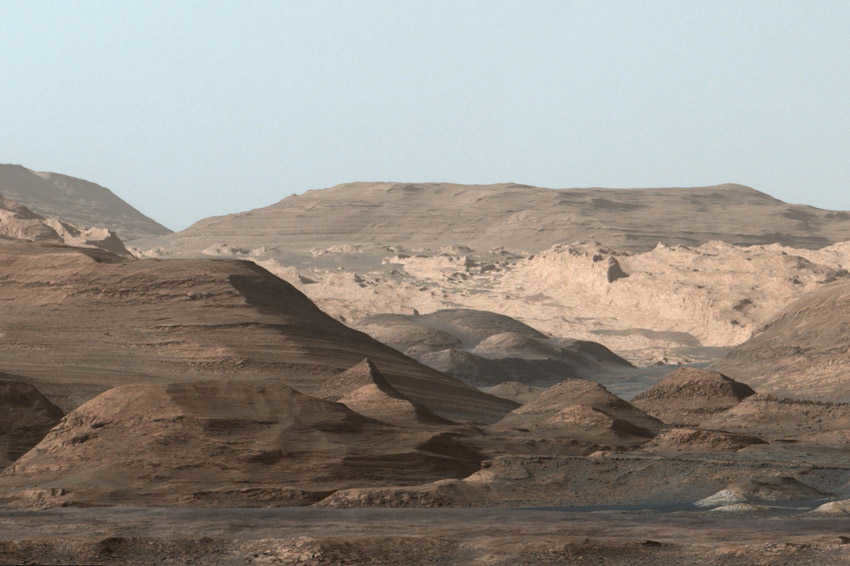
However, not all celestial bodies are suitable for such transformations. The second Earth needs to be located in the “green zone” – at an optimal distance from its star. It should also have a gravity that is comparable to Earth’s gravity, allowing for normal movement of humans and animals. Other conditions can be adjusted as needed: an atmosphere can be created, water can be brought, and the surface can be heated. In our Solar System, Mars is the most likely candidate for this role: it is relatively close to the Sun, it has a suitable gravity, and the presence of polar ice provides a valuable source of water and greenhouse gases.
The Hut of Terraformers. A Temporary Residence on an Uninhabited Planet.
Prior to commencing the process of transforming Mars, it is imperative to establish a dwelling on the planet. The most optimal approach involves constructing a modest outpost equipped with an enclosed ecosystem and self-sustaining life support systems, effectively insulated from the surrounding environment.
In the 1990s, an endeavor to establish such a foundation was undertaken in the United States. Space Biosphere Ventures constructed “Biosphere-2” in the Arizona desert – an expansive compound comprising enclosed greenhouses spanning a total area of 1.5 hectares. These greenhouses encompassed diverse biomes found on Earth, including deserts, savannahs, forests, and even a scaled-down ocean. The compound housed 46 species of edible plants, as well as goats, pigs, chickens, and fish in its reservoirs. A transparent roof supplied solar energy for plant photosynthesis, while waste processing was facilitated by worms and soil bacteria. The ventilation system and water cycle were isolated from the external environment.
Two separate trials were undertaken, involving eight and seven individuals, respectively. The initial one spanned from 1991 until 1993. Unfortunately, it was unsuccessful, as the greenhouses became infested with pests, numerous plants withered away, oxygen levels decreased, and both humans and animals had to be evacuated. The subsequent trial commenced in March 1994 but was terminated after only six months due to insufficient financial resources.
In the 1970s, the Krasnoyarsk Institute of Physics named after L.V. Kirensky, USSR Academy of Sciences, constructed a residential module called “BIOS-3”. This module was relatively small, with a volume of only 315 m3, and was designed to accommodate three individuals. The goal of the experiment was to create a closed system for air and water supply. Inside the module, grains and fruit crops were grown to provide 80% of the food, while the remaining 20% was sourced from supplies. The experiment, which lasted for 180 days as originally planned, concluded successfully without any significant incidents. Currently, efforts are being made to revive and continue this project.
Starting the process of terraforming, naturally, involves the establishment of a thick atmosphere resembling that of Earth. This endeavor necessitates the presence of liquid water and favorable temperatures, as these factors are interdependent and can only exist in conjunction with one another.
One widely discussed method involves bombarding Mars with comets or asteroids. This concept has been suggested by physicist, astronomer, and futurist Michio Kaku, astrobiologist Chris McKay from NASA, and Robert Zubrin, an engineer and the founder of the Mars Society, at various points in time.
The closest approximation to the natural option would be if we assume that liquid water and atmosphere emerged on Earth due to the impact of a large number of icy comets. Upon impact, a considerable portion of a comet or meteorite would melt or vaporize, giving rise to dust clouds in the atmosphere. The numerous powerful collisions would then lead to the release of greenhouse gases, resulting in the heating of the planet’s surface and the melting of ancient glaciers.
Implementing a logical approach to redirecting comets and asteroids to hit the surface of Mars is a challenging task. Firstly, there is still uncertainty surrounding the method of redirection itself. Secondly, the lack of sufficient gravity on the Red Planet poses a major challenge in maintaining a stable atmosphere, which would need to be regularly replenished. Finally, these manipulations carry the risk of causing significant overheating or supercooling on Mars, with unpredictable outcomes.
Detonating Thermonuclear Charges: A Unique Option for Post-Apocalypse Enthusiasts
A novel concept for creating a habitable atmosphere on Mars was proposed by American inventor and entrepreneur Elon Musk last year. Musk suggested detonating powerful thermonuclear charges at the poles of the Red Planet to vaporize water and carbon dioxide from the polar ice. This process would initially result in the formation of a dense atmosphere, and over time, the concentration of greenhouse gases would lead to a rise in surface temperatures, potentially creating a liquid ocean.
Compared to the redirection of comets and asteroids, this method is relatively straightforward. However, it poses a significant risk of radioactive contamination, effectively transforming Mars into a planet resembling Earth after a nuclear war. Consequently, the appeal of settling on Mars may be limited to those with a fascination for the post-apocalyptic scenario.
Constructing Reactors for Radiation Control
Speaking frankly, the initial two techniques for creating an atmosphere on Mars are rather awkward and forceful. Nonetheless, Michio Kaku proposes a gentler and safer strategy for terraforming the Red Planet – the construction and launch of thermonuclear reactors at the Martian poles. These reactors would also serve to heat and melt the polar ice caps. It is worth noting that water is commonly used as a coolant in nuclear power plants, which would simplify the task even further: the Martian glaciers could be utilized as a working medium.
This approach would prevent catastrophic explosions, shocks, and the contamination of Mars with radioactive materials. Granted, it must be acknowledged that the process of submerging the Martian polar caps would require more than a century. Additionally, the construction and establishment of secure maintenance for such fusion reactors is a daunting prospect to consider.
Methane-freon plants. Planetary gasification
A potential method for generating an atmosphere on Mars involves the establishment of 100-150 factories across the planet’s surface that would produce greenhouse gases such as methane and Freon. According to Zubrin and McKay, these factories, if operated continuously, could create an atmosphere with the desired density within a timeframe of 10-30 years.
Engineers have chosen to focus on these gases due to their minimal impact on the future ecosystem, while still providing a strong greenhouse effect that is necessary for the survival of oxygen-producing autotrophs. These autotrophs are organisms capable of synthesizing organic matter from inorganic sources.
A similar concept is presented in the book “Physics of the Future” by Michio Kaku. He suggests using methane and Freon, which are found on Mars, as well as ammonia, which can be processed and utilized as fertilizer.
Enormous solar-powered mirrors: transforming Mars
Orbital mirrors can be employed to initiate the global warming process and facilitate the development of an atmosphere on Mars. These mirrors would be positioned near the Red Planet and redirect solar rays towards the ancient ice.
The people of Earth have already attempted to create space mirrors, although their efforts have not been very successful. In the 1990s, Roscosmos launched two satellites, Znamya-2 and Znamya-2.5, into orbit. The first satellite successfully unfolded a 20-meter sail made of reflective metallized film, which was used to create a sun bunny on Earth with a width of approximately 8 km. However, the second sail, with a diameter of 25 meters, was unable to be deployed. Another satellite, called “Znamya-3”, was initially planned, but it was ultimately canceled due to the failures of the previous experiments.
Other countries have also proposed similar projects, but none have achieved successful results yet. It is likely that this task is not a priority for any space program, which is not surprising considering the more important tasks that need to be addressed in space.
In order to thaw the icecaps on Mars, a network of enormous mirrors, each measuring several kilometers in diameter, would be necessary. Assuming that within a century we will have the capability to produce and transport such mirrors to Mars, as well as successfully install and calibrate them, time is of the essence.
Sprinkle regolith. The takeover bid
And, maybe, the final and not the safest method of atmosphericization. It is also connected to the light manipulation game – entails covering the polar Martian caps with a thick layer of dust, in order to reduce their sunlight reflection and gradually cause melting.
However, the question is, where can we obtain this dust? It would be too labor-intensive to transport it from Earth. It would be simpler to gather it from Mars’ natural moons Phobos and Deimos. Similar to most small, non-atmospheric space rocks, they are fully and abundantly covered with regolith (loose, sandy-like soil). This results in a very low albedo (reflection coefficient) for the moons – only 0.07 (in comparison, Earth’s albedo averages 0.31, while Mars’ is 0.16). Therefore, it can be assumed that the regolith from the surface of the Red Planet’s moons will be sufficient.
Cyanobacteria thriving in every tiny pool. Enriching the atmosphere with life-giving oxygen
Suppose we were to implement one of the aforementioned concepts and successfully establish a dense atmosphere on the red planet. The next crucial step would be to infuse it with an ample supply of oxygen, a vital element for the sustenance of human beings and various other forms of earthly life.
According to Charles Cockell, a professor at the University of Edinburgh and director of the UK Center for Astrobiology, if Mars has water, the right temperature, and a stable atmosphere, cyanobacteria could play a crucial role. These remarkable single-celled photosynthetic organisms were responsible for the “oxygen catastrophe” that altered Earth’s atmosphere. One of their key strengths is their resilience and ability to reproduce rapidly. Water is essential for their reproduction, making it ideal to populate all the water bodies on Mars, from large bodies to small puddles. However, caution must be exercised, as certain species of cyanobacteria can release toxic substances instead of oxygen.
Gray-green Mars: Revolutionizing the Planet
An innovative approach to generating oxygen on Mars has been proposed by Eleanor Robbins, a researcher from the University of San Diego (USA). The method involves introducing anaerobic iron-reducing bacteria into the moistened Martian soil, which can release oxygen from iron and manganese oxide compounds.
Mars is known for its ochre-red color, which is predominantly due to the high concentration of iron oxides in its soil, accounting for nearly 15% of its composition. For certain bacteria species like Geobacter metallireducens, these compounds serve as an ideal energy source, as they can reduce them to hydroxides while simultaneously releasing oxygen. The resulting mixed iron hydroxides display a distinctive greenish hue. Therefore, if we were to proceed with terraforming Mars based on this concept, we should expect the planet’s color to transition from red to gray-green or brown.
The Agrarian Phase: Cultivating Fields and Introducing Livestock
After successfully oxygenating the atmosphere, we can now focus on the next step in Mars’ development: agriculture. Our first priority is to populate the Martian soil with essential organisms such as algae, bacteria, fungi, and other microorganisms. Over time, these organisms will contribute to the formation of humus, creating a fertile layer of soil. With this foundation, we can then proceed to cultivate more complex forms of life. Starting with plants like clover and potatoes, we can gradually introduce a variety of useful vegetation. Additionally, we can introduce livestock such as sheep and cows to graze on the fields and meadows of our Martian landscape…
P. S.
Warning! Please refrain from attempting to replicate the methods described above (particularly nuclear detonations) in your own household – here on Earth. Additionally, it would be wise to reconsider any plans of relocating to Mars. The modifications mentioned earlier are far from sufficient in order to support life on the planet. Prior to any alterations, it is imperative to fortify Mars’ magnetic field and gravity, otherwise any atmosphere produced will inevitably dissipate. Even the most brilliant thinkers have yet to propose viable solutions for this colossal undertaking.
Bombardment by Comets and Asteroids: A Potential Solution for Creating an Atmosphere on Mars
In order to establish a sustainable atmosphere on Mars, the presence of liquid water and optimal temperature are crucial factors. These elements are inherently intertwined and cannot exist independently. An intriguing proposition that has gained significant traction is the idea of bombarding the red planet with comets or asteroids. This concept has been suggested by renowned individuals such as physicist, astronomer, and futurologist Michio Kaku, NASA astrobiologist Chris McKay, as well as engineer and founder of the Mars Society Robert Zubrin.
If you accept the theory, this approach closely resembles nature itself, as it suggests that the presence of liquid water and atmosphere on Earth can be attributed to the influx of a significant number of icy comets. As these comets collide, they undergo a process of melting or vaporization, leading to the release of dust particles into the atmosphere. With multiple intense impacts, Mars would experience a similar phenomenon, resulting in the buildup of greenhouse gases that would raise its temperature and cause the melting of ancient glaciers.

Nevertheless, implementing this strategy is rather challenging since the means of redirecting comets and asteroids to hit the target with precision remain unclear. Additionally, such bombardment could lead to significant fluctuations in Mars’ temperature, making it difficult to predict the planet’s behavior accurately. Moreover, due to its insufficient gravity, Mars lacks the capability to sustain a stable atmosphere, necessitating regular replenishment.
A proposition for a thermonuclear assault on the poles
Ilon Musk, the American innovator and entrepreneur, has put forward a proposal to detonate powerful thermonuclear charges at the poles of Mars. The purpose of this operation is to create a dense atmosphere by evaporating water and carbon dioxide from the polar ice. These elements would then contribute to the formation of a thick atmosphere. Over time, the concentration of greenhouse gases would cause the surface of Mars to warm up, leading to the emergence of a liquid ocean.
While this option is certainly easier than bombarding Mars with comets, it comes with the significant drawback of intense radiation contamination. Consequently, after its implementation, it is highly unlikely that anyone would desire to inhabit Mars, as this approach would transform the planet into an environment similar to Earth after a nuclear war.
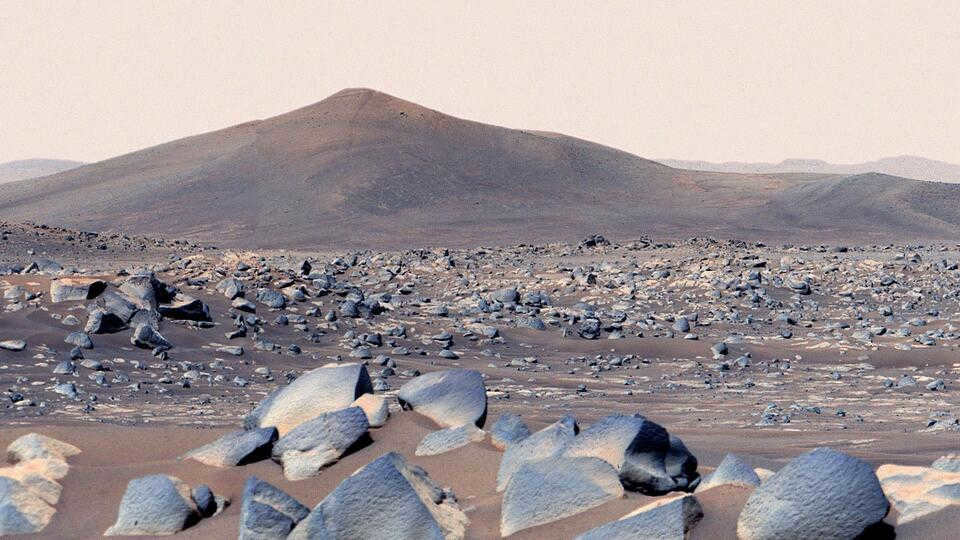
Development of Nuclear Reactors
In terms of terraforming Mars, Michio Kaku has put forward an innovative proposal. The concept involves constructing and deploying fusion reactors on the planet, with the aim of raising the temperature and causing the polar ice caps to melt. However, it is important to note that this process will require several centuries to complete. Additionally, the construction and safe operation of these fusion reactors will also entail a substantial amount of time and effort.
Methane-Freon Gasification of Martian Plants
In order to establish a breathable atmosphere on Mars, experts have proposed the construction of 100-150 plants that produce greenhouse gases, specifically methane and Freon. These plants would need to be evenly distributed across the planet. Zubrin and McKay are optimistic that within a span of 10-30 years, it would be possible to achieve the desired atmospheric density, as long as the factories operate continuously.
Furthermore, the release of these gases would have minimal negative impact on the future ecosystem, while generating a potent greenhouse effect. This would create a favorable environment for autotrophic organisms, which are capable of synthesizing organic matter from inorganic sources, to thrive on the planet.
A proposal has been put forward by scientists suggesting the utilization of orbital mirrors in order to initiate the process of global warming, leading to the eventual creation of an atmosphere. To bring this concept to fruition, the mirrors would need to be positioned in close proximity to Mars, with the aim of directing immense rays of sunlight towards the ancient ice.

Human beings have already attempted the creation of space mirrors, but the outcomes were not particularly successful. Back in the 1990s, Roscosmos launched the Znamya-2 and Znamya-2.5 spacecraft into Earth’s orbit.
The former spacecraft even succeeded in unfurling a 20-meter-long sail made of thin, reflective metallized film and beaming sunlight to Earth for a distance of eight kilometers. However, the second sail, which had a diameter of 25 meters, could not be deployed. Other countries have also put forth similar proposals, but these experiments have failed to yield any significant results.
In order to melt the glaciers on Mars, mirrors with a diameter of several kilometers would be required. The challenge lies not only in the manufacturing of such colossal reflectors, but also in their transportation to Mars, as well as their deployment and calibration. This process would likely span over a century.
Betting on Absorption
One effective method of atmosphericizing entails the application of a generous layer of dust onto the polar Martian caps. This would result in diminished reflection of the sun’s rays, leading to the gradual melting of the caps. However, obtaining this dust from Earth can be quite costly. As a potential solution, scientists propose extracting the dust from Mars’ natural satellites, Phobos and Deimos. These moons are entirely covered with regolith, which refers to loose and crumbly soil.
A team of researchers from McGill University in Canada has conducted calculations to determine the impact of reducing the albedo (reflectance) of the polar caps from 0.77 to 0.73. By making this slight adjustment, equivalent to a decrease of only four hundredths, the glaciers would transform into water within a few hundred years.
Magnetic Shield
Experts theorize that over billions of years, approximately 90% of the Martian atmosphere has dissipated due to the solar wind. As a result, the pressure near the surface of Mars currently stands at 0.7-1.155 kPa, which is only about 1/110 of Earth’s pressure. If the atmospheric pressure on Mars could be increased to about half or even a third of Earth’s pressure, it would allow colonists to venture outside without the need for spacesuits during certain times of the day and year. Moreover, this would create a more hospitable environment for many Earth-based organisms on the Red Planet.
According to NASA specialists, there is a belief that the atmospheric pressure on Mars can be increased by protecting it from the solar wind with the help of a magnetic field. Jim Green, the Director of NASA’s Science Division, has suggested the creation of an artificial magnetic field on Mars. To achieve this, a magnetic shield called Mars L1 needs to be constructed, which will shield the planet from the solar wind and allow its atmosphere to gradually recover.

The magnetic shield is planned to be positioned in a stable orbit between Mars and the Sun. The creation of this shield will involve the use of a massive dipole or two magnets with opposite charges. After several years of deploying the magnetic shield, the pressure on Mars is projected to reach half of that on Earth. This conclusion was drawn by the proponents of the idea based on simulation models of the shield.
In the future, the polar regions of Mars will witness the vaporization of carbon dioxide, transitioning from a solid to a gaseous state. This will initiate the greenhouse effect, leading to a rise in temperature and the melting of ice, ultimately resulting in the planet being covered with water. Scientists believe that these conditions existed on Mars approximately 3.5 billion years ago.
Hey there, hubraludes! Hope you’re having a fantastic end to the week. As we’ve discussed in previous articles about Mars and related subjects, the idea of establishing a permanent settlement on Mars is a hot topic that has captured the attention of many individuals. If you’re one of those individuals who is passionate about seeing apple trees thrive under the Martian sky, then you’re in the right place.

So, let’s envision a scenario where one beautiful morning, the human race woke up and made the collective decision to transition into a multiplanetary society. This idea resonates strongly with me, as I am eager to reside in a world where resources are allocated towards the exploration and colonization of space, rather than the development of weaponry. However, let’s return to the matter at hand: humanity has resolved to construct a second Earth, also known as Earth 2.0. We have limited options available to us, specifically two: Mars and Venus. For the purposes of this discussion, we will focus on Mars.
Some individuals may express the sentiment: “Oh, Mars – it bears such resemblance to Earth! With a few adjustments, we could easily inhabit it!” Indeed, Mars shares a nearly identical tilt of its rotational axis with Earth. Additionally, the length of a Martian day is nearly equivalent to that of Earth’s. However, these similarities are where the favorable comparisons between Mars and Earth end, and the immense challenges arise. The intent of this article is to bring attention to the rather discouraging predicament surrounding Mars.
Technology
However, we are not fearful and firmly believe that our path does not involve living under glass and steel domes. Before we commence, I would like to establish the technological capabilities that humanity should possess at the onset of Mars transformation.
- Achieve travel speeds approaching that of light.
- Develop space portals for the transportation of people and cargo.
- Harness the power of nuclear fusion.
- Extract and process raw materials from celestial bodies such as asteroids, moons, and planets.
- Construct settlements in outer space, distant from Earth.
- Create self-sustaining closed ecosystems within space settlements.
- Erect colossal structures in outer space to maximize solar energy utilization.
- Establish distant Earth-based manufacturing facilities that can produce autonomous interplanetary stations, robots, engines, and other equipment.
- Develop cutting-edge artificial intelligence systems capable of overseeing asteroid mining operations, station construction, and deep space manufacturing plants.
- Construct space elevators or other efficient mechanisms for transporting cargo into orbit.
- Enhance interplanetary travel speed within the solar system by utilizing nuclear propulsion engines or other state-of-the-art technologies.
Magnetosphere
While I acknowledge that some may argue that a dense atmosphere can suffice without a magnetosphere, I believe that having a magnetosphere is crucial. A magnetosphere helps to slow down the process of atmospheric escape into outer space, which is especially important for a planet like Mars. Life on Earth has evolved to thrive within a magnetic field, whereas Mars lacks a magnetosphere. As a result, the solar wind blows away the remnants of its atmosphere, and high-energy particles freely penetrate the Martian surface. There are at least two possible solutions to the magnetosphere problem. One option, as previously discussed on Habra, is the creation of an artificial magnetic shield. This option is relatively cost-effective, but it is essential for the system to work consistently. However, I am somewhat skeptical about how a magnetic umbrella can be maintained in a stable orbit for an extended period, considering its constant interaction with a significant stream of charged particles from the Sun. Essentially, it resembles a massive electromagnetic solar sail.
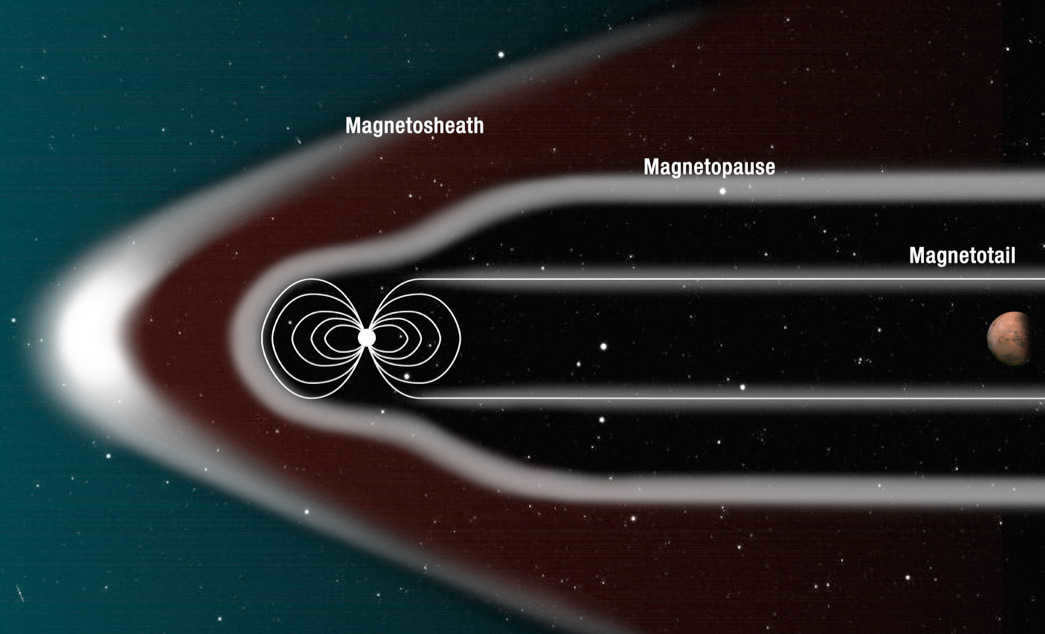
Another option is to attempt the revitalization of the Martian magnetosphere. This endeavor will be extremely challenging, if not outright impossible. However, I will delve into this idea further to provide the reader with an understanding of the immense task that would be required on Mars. The concept revolves around constructing a colossal satellite in Martian orbit that would induce tidal forces in the planet’s core, thereby initiating a planetary dynamo. The cost of such a project would be astronomical, but if successful, it would yield several advantages:
- There would be no need to worry about the artificial magnetic shield being disabled by a meteorite collision with the satellite.
- The reawakening of Martian volcanism could lead to a beneficial influx of volcanic gases into the atmosphere.
- This approach offers a realistic, long-lasting, and maintenance-free solution.
- It would stabilize the tilt angle of Mars’ rotational axis.
- If implemented properly, it is entirely possible to achieve lunar cycles that resemble those of Earth.
- Martian astrologers will enter a new era of astro-forecasting. Three moons in the sky! Three.
More numerical data on masses and diameters will be provided later in the text. And if you still haven’t fully comprehended the magnitude of what we’re discussing here, here’s another comparison:
Imagine if we could construct a moon that orbits Mars by extracting building materials from the surface of the planet. Let’s say we have a powerful rocket capable of launching 100 tons of cargo into the desired orbit. Now, let’s suppose we launch 10 of these rockets every hour, non-stop, 24 hours a day. If we continue this operation, it will take us an astonishing 900 billion years to complete the project. (I must mention that the analogies I’m using here are purely hypothetical, and it’s possible that by the time humanity seriously considers terraforming other planets, we will have advanced technology to transport massive objects through space with relative ease).
Impressive, isn’t it? But the story doesn’t end here; it only gets more fascinating.
Environment
We are still striving to replicate Earth-like conditions on Mars. As we stand in the midst of the Martian desert, we envision lush gardens, just as a Finn standing in the Sahara dreams of Finland and smelt. However, unlike the Finn, we face a grave predicament: the absence of breathable air. Mars lacks the necessary gases to generate a dense and breathable atmosphere. In fact, the Martian atmosphere is scarcely denser than a vacuum. Therefore, we must assess our available resources and introduce what is lacking. On Mars, there are 173 thousand tons of gases per square kilometer of surface, with carbon dioxide comprising 95% of this total. If we desire to achieve an “Earth-like” environment, we would require 10 million tons of gases per square kilometer of surface, with oxygen constituting 22% and nitrogen accounting for the remaining 78%. However, can we forgo nitrogen and rely on CO2 or another gas? Unfortunately, this is not possible. Nitrogen plays a crucial role in maintaining a neutral and stable atmosphere. Unlike carbon monoxide, nitrogen is not as actively fixed by the biosphere. Moreover, atmospheric nitrogen is an essential component in the majority of molecules that constitute the known forms of life. Nitrogen molecules form the core of amino acids, which in turn create protein structures. The importance of nitrogen in the DNA molecule is illustrated below (highlighted in blue). Hence, without nitrogen, life as we know it would be impossible!
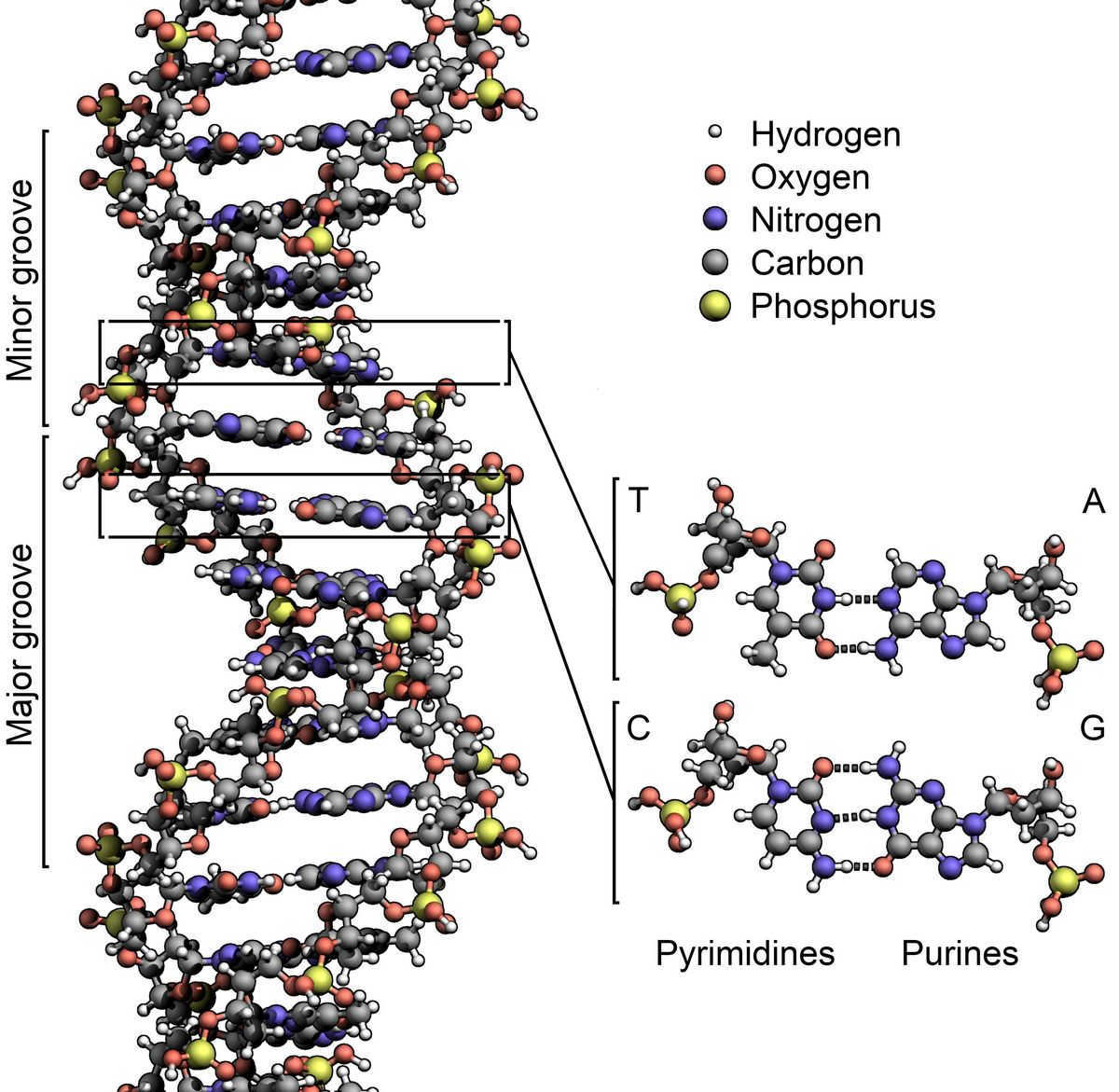
Hydrosphere
Contrary to the information provided on Wikipedia stating that melted Martian ice could potentially cover Mars with an ocean 35 meters deep if it were evenly distributed, I regret to inform many that Mars is an extremely arid planet. If all of the water on Earth were evenly spread across its surface, the depth of the oceans would reach 2.7 kilometers. Despite this, Earth’s deserts are still quite expansive. In the case of Mars, even with a significant increase in atmospheric pressure, water can only be observed in the form of polar caps, as well as snow on Olympus Mons. Therefore, it is necessary to bring water from external sources. However, the amount of water required for Mars is insignificant compared to the quantity of atmospheric gases.
On average, there is approximately 2.6 billion tons of water per square kilometer of Earth’s surface. In order to establish a similar water-to-surface ratio on Mars, it would require the delivery of 3.27×10⁷ tons of water to the planet. This amounts to an ice ball with a diameter of approximately 900 kilometers, which is comparable in size to Ceres. It is a sobering fact that we will need to transport water to Mars for a much longer duration than we will have to address the atmospheric differences. In terms of mass, the deficit in the hydrosphere is approximately 230 times greater than the deficit in the atmosphere. This is certainly something to ponder, Elon Musk!
Biosphere
The Earth’s biosphere weighs approximately 2.4 trillion tons, averaging at 4,700 tons per square kilometer. If we were to translate this to Mars, it would amount to around 680 billion tons. On one hand, this might seem insignificant and easily overlooked. However, the question remains: how many chemical elements essential for life do Martian rocks contain and what needs to be added (and in what quantity)? Currently, our understanding of the chemical composition of Martian rocks is incomplete.
Assuming that the biomass density is equivalent to that of water, a potential Martian biosphere could fit inside a sphere with a diameter of 11 kilometers (if we consider one cubic meter of biosphere to have the same mass as one cubic meter of water).
To summarize our deficits on Mars, let’s refer to the following illustration:
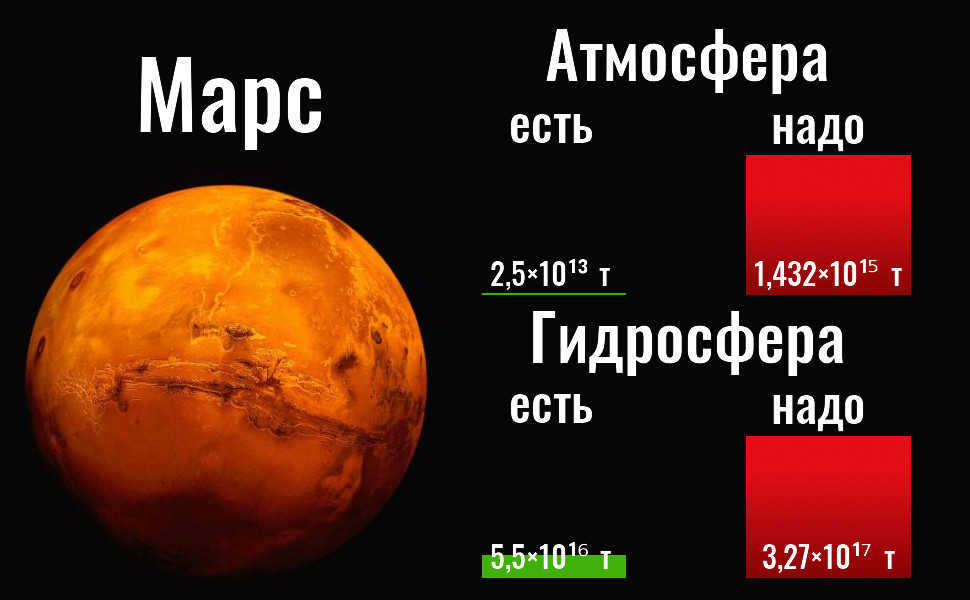
As an alternative to a concluding statement.
This article may disappoint some hopeful individuals who believe that Mars can be terraformed in the near future. Unfortunately, even our distant descendants will not witness the flourishing of apple trees under the Martian sky. While we can indulge in endless fantasies about detonating thermonuclear charges on the polar caps or introducing genetically modified bacteria and lichens to the equatorial regions, the reality is that Mars lacks the necessary building blocks to create conditions and a biosphere akin to Earth’s. However, I am not suggesting that we abandon the dream of terraforming Mars. On the contrary, if we are truly committed to expanding beyond our home planet and establishing habitable conditions on other celestial bodies, it is crucial that we fully comprehend the complexity of this endeavor. This understanding will serve as a vital stepping stone towards developing the tools and technologies needed to accomplish our ultimate goal. Additionally, humanity must shift its mindset from seeking immediate gains to planning for the long term, spanning millennia. Nevertheless, this discussion belongs to a different realm entirely.
And as a token of solace, I present to all those who are interested the opportunity to appreciate the splendid depictions of a terraformed Mars. Hallelujah!)
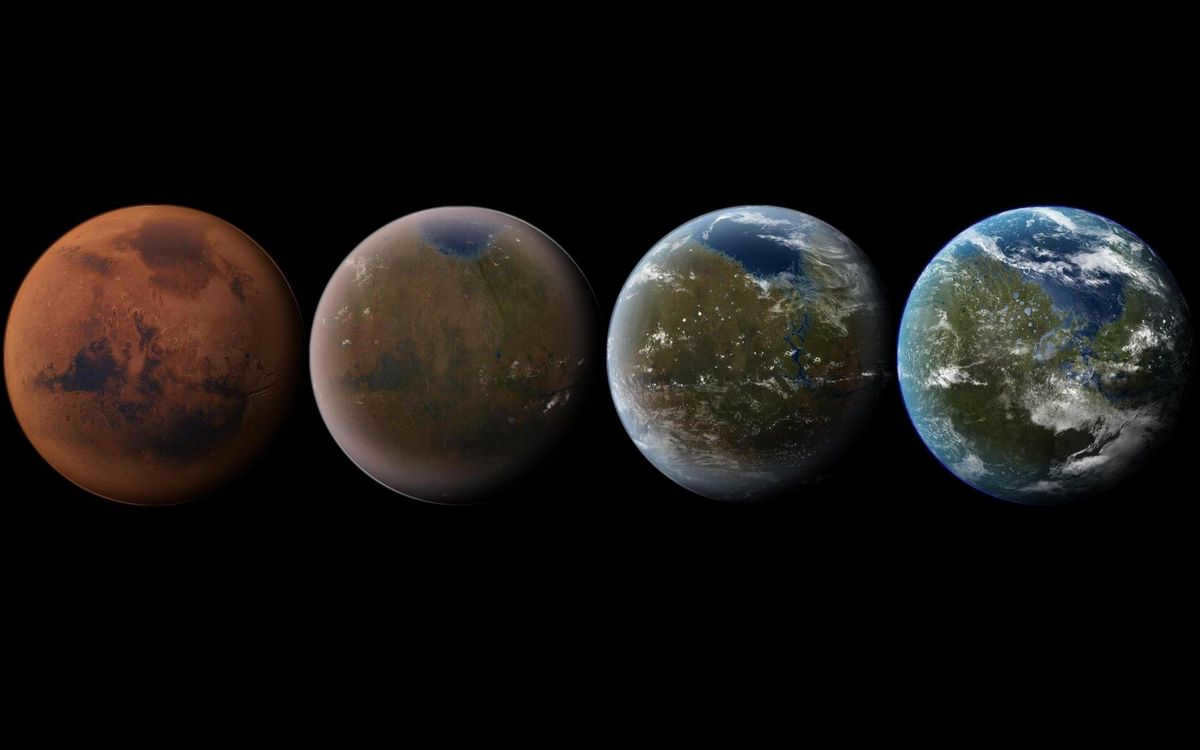
P.S.: Don’t forget: do we need an article discussing the technologies that can be utilized for terraforming Mars and where we can obtain the necessary building materials?
The aspiration of humanity to have a backup planet for sustaining life has faced significant challenges. Research conducted by the MAVEN probe indicates that the carbon dioxide reserves on Mars will not suffice in creating the required atmospheric pressure to enable colonization of the planet. “Hitech” has translated and adapted an article from WIRED that explores the obstacles faced by colonizers, the debates within the scientific community, and the minimal prerequisites for life on Mars.
Accumulate all the carbon dioxide and release it into the atmosphere
The aspiration of humanity is to embark on a journey to Mars. Our strategy is robust and well-designed. It involves launching a rocket with astronauts on board, establishing a lunar base, and progressively increasing the number of rockets and crew members. We aim to initiate fuel production on the Martian surface and potentially establish a depot at a strategic point during the mission. This outpost will eventually evolve into a permanent base, transforming into a self-sustaining domed city. The ultimate objective is to engage in terraforming, altering the planet’s environment to make it habitable for humans.
Let’s revive the lifeless planet Mars by utilizing its frozen carbon dioxide to create a fresh atmosphere. By increasing the air pressure and introducing greenhouse gases, we can hope to induce a warming effect (you’re aware of their impact on climate change, right?). Our goal is to make Mars so warm that the underground frozen water thaws and transforms into flowing rivers – just like Earth’s oceans! We’ll even have breathable air, enough to sustain us without the need for spacesuits. However, patience is required as this process may take approximately 10,000 years to fully unfold. Once accomplished, we’ll be able to adapt to the Martian environment and explore the possibilities of a thriving colony, just as depicted in science fiction literature.

According to Bas Lansdorp, the co-founder of Mars One, his wife would do anything to avoid going to Mars.
Although it may seem unconventional, the idea of terraforming Mars has been around for a while. In 1971, the renowned astronomer Carl Sagan proposed the concept of “planetary engineering,” which involved melting water vapor from Mars’ polar ice in order to create more favorable conditions. Building on this idea, astrobiologist Christopher McKay suggested that if Mars still possesses sufficient carbon dioxide, water, and nitrogen, it may be possible to terraform the planet and create a habitable atmosphere.
Carbon is present, but in extremely limited quantities
However, a number of scientists studying Mars are dispelling the notion of a “extraterrestrial” paradise. According to the latest analysis, the conditions on Mars make it impossible for existing technology to transform it into a lush and fertile environment resembling Earth.
“For the first time, we have managed to collect a sufficient amount of CO2 on Mars,” explains Bruce Jakoski, a researcher at the University of Colorado and co-author of the new study alongside Christopher Edwards from Northern Arizona. “Most of the carbon has been lost to space, with only a small amount remaining in polar ice and carbon-containing minerals. The quantity of carbon present in deep carbonates remains unknown.”
Even the inclusion of CO2 that is trapped on rocks, “adsorbed” onto their surfaces, and from the cells of water molecules known as clathrates will not salvage the predicament.
“Even if all of it is introduced into the atmosphere, there will still not be sufficient amount to raise the temperature of the planet,” Yakoski stated with certainty.
The barometric pressure on the surface of Earth is approximately 1 bar. To raise the surface temperature on Mars to above freezing, a certain amount of CO2 would be necessary. Even a pressure of 250 mbar would have a significant impact on the climate. In the past, Mars had a different geological makeup and surface appearance. Various factors suggest that liquid water once existed on the planet’s surface. This implies that Mars had sufficient warmth and pressure to sustain liquid water. If Mars had the same CO2 levels as Earth and Venus, it would have mineralized carbon equivalent to 20 bars, which would be locked in the polar ice as carbonate. This would already be a partially sufficient amount.
Insufficient Pressure
Recent radar findings have revealed the presence of CO2 deposits in close proximity to the polar caps on Mars. The Mars Reconnaissance Orbiter has collected comprehensive data on the distribution of carbonates, while the MAVEN probe, which has been in orbit since 2014, has been quantifying the loss of gases into space. The principal investigator of this mission is Jakoski. The implications of these findings are quite alarming when considering the potential for terraforming.
MAVEN – Mars Atmosphere and Volatile Evolution, is an American satellite created to study the atmosphere of Mars as part of the Mars Scout project.
The objective of the mission is to investigate the present condition and development of Mars’ atmosphere, particularly the depletion of its atmosphere. MAVEN will analyze the rate of atmosphere loss, enabling us to comprehend the role it has played in the progression of Martian climate change. The MAVEN project has a price tag of $671 million.
Approximately 15 mbar can be obtained from the polar caps. Rocks have a pressure of less than 15 mbar, but they could potentially reach up to 150 mbar if they are heavily reinforced. Adsorbed gas in the regolith? Only 40 mbar, even if the entire Martian soil is excavated down to a depth of 100 meters.
"Increasing the readings by a mere 40 or 50 mbar is an arduous task, and it is insufficient. Such a slight change will not have an impact on the temperature," Jakoski explains. – Doubling or tripling the value might potentially be achievable, but even then, it would fall far short of the temperature required for substantial warming."
Alternatively, he could be mistaken. Christopher McKay, a pioneer in terraforming, maintains optimism.
“The crucial factor in terraforming is the presence of CO2, N2, and H2O on Mars. Unfortunately, there are no other fundamentally different methods to tackle this challenge,” writes McKay.
Jakoski’s findings from MAVEN indicate that carbon is partially escaping into the atmosphere, albeit within certain limits. Additionally, many of the potential sources for the future atmosphere still exist. As a result, McKay suggests that it is possible that the necessary conditions are still present.
“We are not yet fully convinced that substantial CO2 deposits exist on the Red Planet. Insufficient data is available, and further research is required,” he explains.
Indeed, Mars is full of surprises: one intriguing discovery is the recent announcement that it is possible to artificially create seas at the polar regions of Mars. The release of uncertain data has sparked excitement among true enthusiasts of the red planet. According to Robert Zubrin, the president of the Mars Society and the author of “The Case for Mars,” he believes that Jakoski’s findings are consistently pessimistic. Zubrin doesn’t require an excessive amount. Just 300 mbar would suffice, which is equivalent to the atmospheric pressure on Everest, for instance.
“With 200 mbar, there would be no need for spacesuits. It would become feasible to construct enclosed domes where the internal pressure matches the external pressure,” Zubrin optimistically asserts.
Zubrin and McKay also point out that expanding on the idea presents a much more positive outlook for Mars. It is possible to use artificial greenhouse gases, such as chlorofluorocarbons created from the abundant chlorine in the Martian regolith, or even more unique and fast-acting options like a “super greenhouse gas.” The challenge lies in discovering how to produce these gases and release them from the laboratories. However, it is crucial to ensure that these gases do not harm the limited ozone layer and that the ultraviolet radiation does not combine with the cosmic radiation bombarding the magnetospheric Mars.

Rockets, monotony, and radiation are the factors that stand between us and reaching Mars.
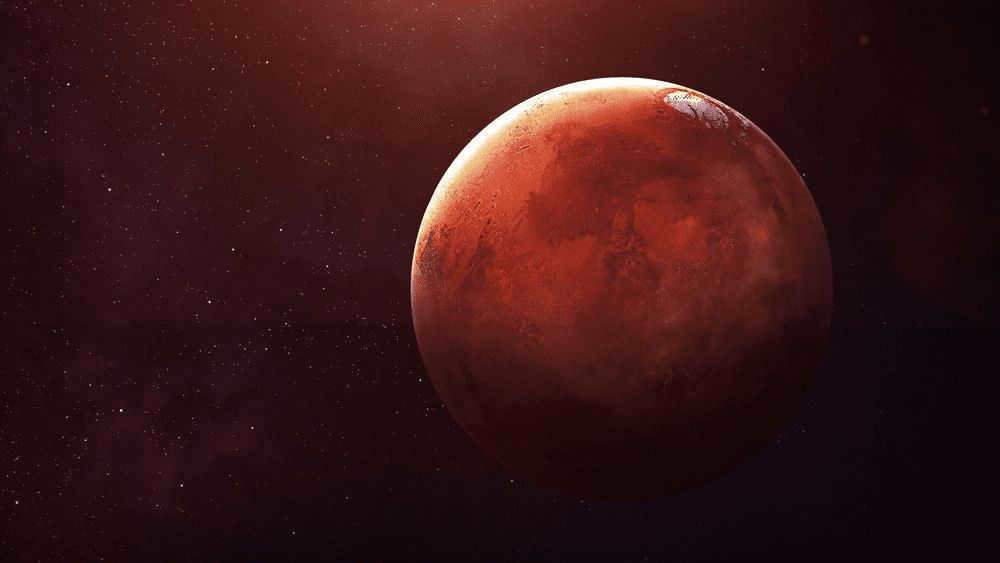
Mars’ polar regions, similar to those of Earth, are covered by a dense layer of ice. Numerous experts, including the founder of SpaceX, Elon Musk, argue that nuclear strikes on Mars’ poles could potentially release significant amounts of carbon dioxide that is currently trapped in the atmosphere and cause the ice to sublimate into water.
Science fiction literature is filled with content about terraforming, which involves the process of transforming a planet to make it habitable and similar to Earth. From HG Wells’ “War of the Worlds” to Isaac Asimov’s “The Martian Way,” people have long been captivated by this concept.
However, terraforming is no longer just a product of the imaginative minds of science fiction authors. Even astronomers are now seriously considering the possibility of terraforming, as we continue to explore the cosmos and strive to establish our first human colony beyond Earth.
So, what is the definition of terraforming, and why could Mars be an ideal location to experiment with this process? Let’s delve into the details!
What exactly is terraforming?
In simple terms, terraforming involves altering the atmosphere and environmental conditions of a planet or celestial body to create a habitable climate for living organisms. The ultimate goal is to modify the climate of a planet in such a way that humans can inhabit it without the need for protective gear.
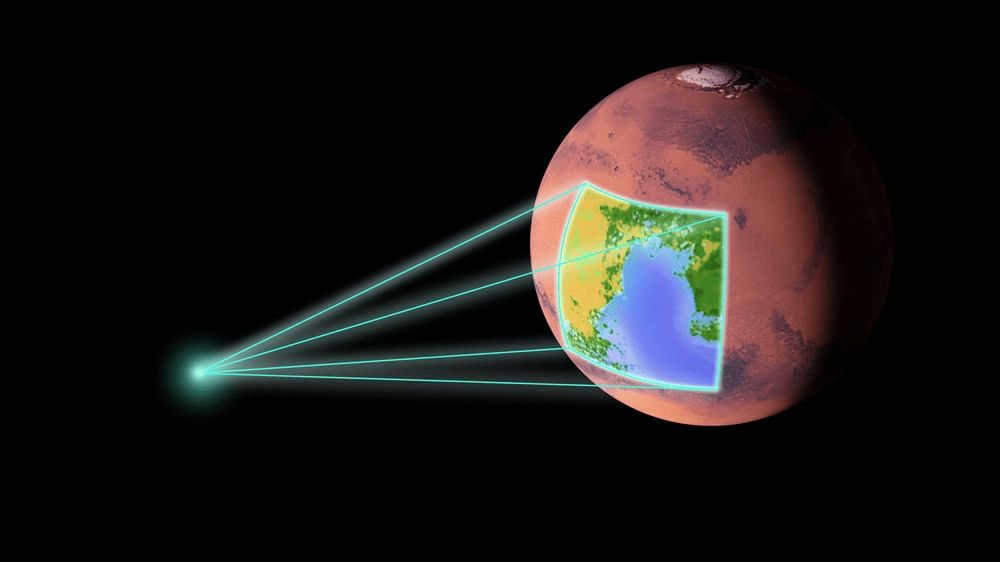
What makes Mars an ideal candidate for terraforming?
Out of the eight primary planets in our solar system, Mars appears to be the most suitable option for terraforming. Why is that the case? Simply put, Mercury and Venus are too hot for spacecrafts or humans to survive. The giant planets, ranging from Jupiter to Neptune, are composed mostly of gas, lacking a solid surface for exploration. Clearly, Mars emerges as the superior alternative.
Tackling Challenges of Terraforming Mars
Nevertheless, the process of terraforming Mars presents numerous obstacles. Mars, with its meager atmosphere and frigid average temperature of -63 °C, poses significant challenges. Furthermore, the air pressure on Mars is less than 1% of Earth’s. Consequently, our initial hurdle involves raising the planet’s temperature and bolstering its atmospheric pressure. Only after these core obstacles are addressed can we begin to address other pressing concerns, such as cultivating crops and safeguarding Martian inhabitants from the hazards of cosmic radiation.
Mars hasn’t always been uninhabitable
Currently, Mars appears to be an inhospitable place for life, but this hasn’t always been the case. Scientists theorize that Mars once had a thicker atmosphere and flowing water. Water, along with breathable air, is a crucial element necessary for survival on any terraformed planet. Regrettably, Mars’ thick atmosphere has gradually dissipated into space over billions of years, causing any water present to freeze or evaporate, rendering the planet hostile to life.
In order to return the planet to its previous state of magnificence and ensure our ability to breathe and remain conscious on Mars, it is imperative that we engage in the process of terraforming its atmosphere. The composition of Earth’s atmosphere consists of 21% oxygen, 78% nitrogen, and 1% other gases and elements. While it may not be necessary to replicate this precise mixture of gases, it is crucial that we attain a comparable quantity of O2.
Gigantic orbital mirrors.
In order to raise the temperature on the cold and desolate planet of Mars, it is necessary to fill its atmosphere with a sufficient concentration of O2. However, this alone will not be enough to make the planet habitable. In 1993, scientists at NASA came up with a groundbreaking idea to warm up Mars. Their proposal involved the construction of enormous orbital mirrors that would reflect sunlight onto the planet’s surface. These mirrors would be strategically positioned around Mars, effectively redirecting sunlight and increasing its intensity. This method can be likened to the ancient Greek scientist Archimedes, who used large mirrors to focus sunlight and destroy enemy ships. By implementing this innovative strategy, scientists believe that even the frozen water (ice) on Mars can be melted, providing us with a vital resource for survival: water.
Greenhouse gases
One way to increase the temperature on Mars is by using greenhouse gases. These gases are notorious for causing global warming on Earth. The key point here is the concept of “warming.” Greenhouse gases have the ability to trap heat in the atmosphere, resulting in an increase in temperature. This is exactly what we need on Mars. In other words, the villain on Earth can become the hero on Mars! Experts propose that greenhouse gases can thicken the atmosphere on Mars, raise the surface temperature, and provide protection against excessive cosmic radiation.
CO2 is the most abundant greenhouse gas on Earth, which raises the question: is there enough CO2 on Mars to thicken its atmosphere?
Exploding an atomic bomb at the polar regions
Similar to Earth, the polar regions of Mars are enveloped in a substantial ice layer. Various specialists, including Ilon Musk, the creator of SpaceX, contend that detonating a nuclear bomb at Mars’ poles could have multiple effects. Not only would it result in the release of a considerable amount of CO2 that is currently trapped in the atmosphere, but it would also cause the ice to sublimate into water.
Martian soil
Extracting carbon dioxide from carbon-rich Martian soil is a challenging task. The process involves heating a carbon-rich mineral found on the surface of Mars to extremely high temperatures, reaching several thousand degrees, in order to release the CO2 trapped within it.
Mars has a vast surface area of approximately 144 million square kilometers, so covering the entire planet with greenhouse gases would require an enormous amount of gas. The scale of this endeavor is almost unimaginable. It would necessitate the construction and operation of massive nuclear power plants on Mars for several decades in order to generate enough energy and greenhouse gases to warm the planet’s surface.
Aerogel: The Lightest Material on Earth

Another factor that might play a crucial role in maintaining heat on Mars is aerogel. Aerogel is considered to be one of the lightest substances ever discovered. It is an ultra-low density solid that consists of 99% air! Moreover, it possesses good insulation properties, which is the reason why NASA has included it in their ongoing Mars rover mission.
In a recently published paper, Harvard scientist Robin Wordsworth demonstrated the potential use of aerogels on Mars. Wordsworth conducted an experiment where he illuminated an aerogel with a lamp, imitating the sunlight on the Martian surface.
According to Wordsworth’s findings, the aerogel successfully maintained the warmth beneath it, reaching temperatures as high as 65 °C. He argues that this type of aerogel coating could effectively retain heat within Mars’ atmosphere.
Regrettably, aerogel is not flawless. It is rather delicate, and manufacturing it in large amounts would be exceedingly challenging.
Comets
Indeed, there is another glaringly aggressive method to terraform Mars – incoming comets!

Comets provide a valuable source of nitrogen, oxygen, and hydrogen, which are essential components for Earth-like atmospheres. If we could devise a means to redirect comets and induce them to collide with the surface of Mars, significant quantities of nitrogen and oxygen could be released into the Martian atmosphere.
Nevertheless, certain experts raise concerns about the potential perils associated with this approach. They contend that bombarding Mars with comets would have devastating consequences. It would eradicate any traces of undiscovered life and obliterate the pristine solar system geology that can no longer be found on Earth.
The initial phase of making Mars habitable would involve sending the first human (or group of humans) to the planet, similar to our previous lunar landing. However, this task alone is incredibly challenging, let alone the ambitious mission of completely transforming the planet. If we continue on our current trajectory, many years in the future, we may achieve this goal, although we would still rely on spacesuits for survival.
Upon reaching Mars, the subsequent step would be to establish a scientific outpost, providing a foundation for sustainable living on an extraterrestrial world. The primary obstacle would be transitioning from a small group of trained astronauts to a massive community of space enthusiasts. To successfully embark on a comprehensive terraforming endeavor, we would undoubtedly require the involvement of thousands of individuals.
The effects of terraforming Mars
The individuals responsible for terraforming Mars will ultimately become Martians themselves. Over time, these Martians will gradually adapt to the unique conditions of their new environment. Due to the significantly lower gravity on Mars, it is likely that Martians will experience physical changes, such as increased height compared to Earth-dwelling humans. Additionally, the altered atmospheric pressure on Mars may lead to modifications in their blood chemistry. As a result, Martians could potentially diverge from humans and evolve into a distinct species. The transformation of pioneers and explorers into Martians will undoubtedly spark further discussions and debates.





